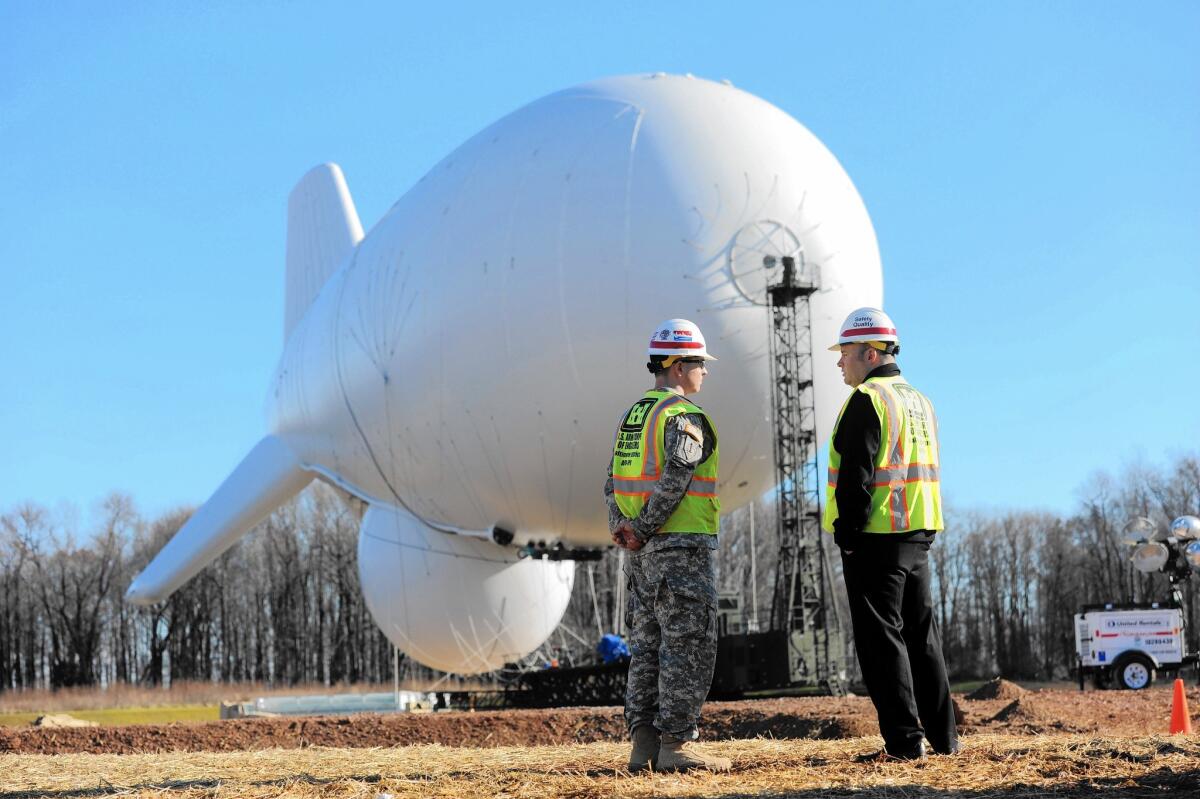A trial balloon on cruise missile defense

- Share via
reporting from WHITE MARSH, Md. — When the weather’s good, a strange speck will be visible on the Baltimore skyline: a giant balloon the Army is floating to scan for cruise missiles.
The balloon — technically an aerostat — took to the air Saturday morning. Two will be floated over Maryland for a three-year test of sensors that can detect and train fire on cruise missiles from hundreds of miles away.
The aerostats are aimed at filling what some military officials see as a gap in U.S. air defenses. But the program has been beleaguered by shrinking budgets and opposition from privacy advocates, who warn that the balloons could be transformed into eyes in the sky, watching the movements of everyone for miles around. Officials emphasize that the balloons to be floated over Aberdeen, near Baltimore, will not carry cameras.
The Army showed off the first helium-filled balloon this month at an Aberdeen Proving Ground annex. The gleaming white, 80-yard-long inflatable hovered just above a wide patch of gravel.
At the briefing, Army Capt. Matt Villa attempted to assuage concern.
“I can’t stress enough there are absolutely no cameras or video equipment on board … the system,” Villa said. “Its radars cannot detect people, it does not store information … it has no weapons on board.”
Military statements notwithstanding, privacy advocates say the balloons, which can float two miles in the air for up to a month at a time, could easily be turned into powerful spying platforms. David Rocah, an attorney with the American Civil Liberties Union of Maryland, described them as the latest example of battlefield technology being brought home for domestic use.
“They enable a kind of persistent surveillance which is not technologically feasible by other means,” he said. “It is that persistence that creates the invasion.”
The Joint Land Attack Cruise Missile Defense Elevated Netted Sensor System — or JLENS — uses sophisticated radar to stare out 340 miles in every direction in search of cruise missiles and other airborne threats.
The balloons work in pairs: One looks for potential threats; the other helps weapons lock onto those threats and, it is hoped, shoot them down. The second balloon is set to rise over Edgewood, Md., early next year.
Data from the sensors are passed down to the ground through the tether and on to the Army’s Aberdeen Proving Ground.
Supporters of JLENS say it will provide long-range radar much more consistently and inexpensively than systems mounted on planes.
Maj. Gen. Glenn Bramhall, whose unit oversees the project, told reporters that cruise missiles are becoming more widely available to U.S. enemies. Chet Nagle, a former Navy aviator and member of the Committee on the Present Danger foreign policy group, said the test would leave Washington better defended against a cruise missile attack.
“There is nothing else we have that will do that,” Nagle said. “Most of our in-place defensive systems are designed for ICBMs,” he said, referring to much higher-flying intercontinental ballistic missiles.
JLENS has seen its scope and funding narrowed.
Defense officials originally wanted to field as many as 16 balloon pairs. But after costs spiked, the program was scaled back, and the pair above Maryland now look to be the only ones in operation.
If the test proves successful, Bramhall said, the program could be expanded. But the House of Representatives attempted to slash by half the $54 million proposed budget for JLENS in this year’s National Defense Authorization Act. The legislation signed by President Obama this month restored most of the money, but Bramhall’s team will have to make do with about $12 million less than it requested.
More to Read
Sign up for Essential California
The most important California stories and recommendations in your inbox every morning.
You may occasionally receive promotional content from the Los Angeles Times.










